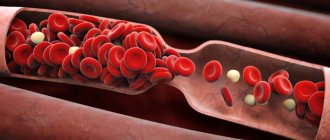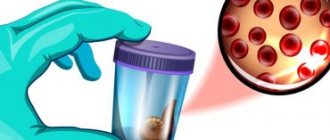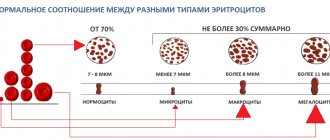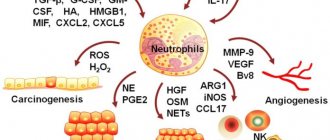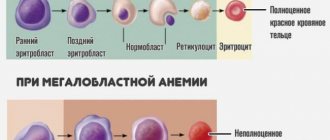It is blood that is the real “river of life” in the human body, and almost all processes occurring in the body depend on its normal composition.
The main problem that arises when the composition of this fluid environment of the body is disturbed is blood thickening, which leads to the work of many organs and systems in emergency mode. The most life-threatening consequences in such cases are heart attacks and strokes, which are a consequence of increased thrombus formation.
A little about the main functions of blood
The main function of red blood cells is to transport oxygen to the cells of the whole body.
All the tasks that the body sets for the blood are carried out thanks to the coordinated work of its following components:
- plasma – the liquid non-cellular part of blood;
- erythrocytes, platelets, represented by various elements leukocytes - cell mass (or suspended formed elements of blood);
- ions of various micro- and macroelements, enzymes, hormones and other substances entering the blood.
All of the above components perform the following functions:
- transport substances necessary for life (hormones, enzymes, nutrients and “fuel” elements) and remove “waste” materials accumulated in the blood (carbon dioxide, etc.);
- regulate the flow of water and electrolytes into the tissue;
- ensure the functioning of the immune system when pathogenic objects (microorganisms, own mutated cells) enter the blood.
A parameter such as blood thickness is determined by the balance between the liquid (plasma) and cellular (formed elements) part of the blood. It is this property that allows it to penetrate the smallest vessels and capillaries. This ensures the necessary delivery of blood to all tissues of the body.
Anemia (or anemia) is accompanied by a decrease in those blood parameters that relate to red blood cells. It is these red cells that carry oxygen, and if their production is disrupted, hypoxia of the tissues of all body systems develops.
Why does blood viscosity change?
Being at the intersection of two powerful flows of toxins (ecology on the one hand and work intensity on the other), the state of the blood reflects the contribution of each component to the rheological properties of the blood. Or rather, the individual characteristics of the human body, the ability to withstand the environment around it.
If your body’s antioxidant potential (the ability to produce and accumulate antioxidants) is high, the blood will be more fluid and such a person is prone to longevity. And the most numerous blood cells in this case, when analyzing a living drop of blood, are located separately.
If the body's antioxidant potential is low, the most numerous blood cells, erythrocytes, agglutinate among themselves, forming bizarre structures resembling coin columns or tiles. Blood viscosity increases and many risks increase.
Increase or decrease in the number of red blood cells in tests. ESR
Red blood cells and their significance in tests: decrease and increase in the number of red blood cells in a general blood test and in urine analysis. Erythrocyte sedimentation rate (ESR) and its meaning.
Erythrocytes (red blood cells, rbc) are the most numerous blood cells that perform the function of transporting oxygen and nutrients to tissues and organs. Red blood cells contain large amounts of the red pigment hemoglobin, which is able to bind oxygen in the lungs and release it in the body tissues.
- A decrease in the number of red blood cells in the blood is a sign of anemia.
- An increase in the number of red blood cells in the blood can be observed with severe dehydration, as well as with erythremia.
- The appearance of red blood cells in the urine can occur with inflammation of the urinary system (kidneys, bladder).
What are red blood cells?
Erythrocytes, or red blood cells, are the most numerous blood cells. Red blood cells have a regular disc-shaped shape. At the edges of the red blood cell, it is slightly thicker than in the center, and on a section it looks like a biconcave lens, or dumbbell. This structure of the red blood cell helps it to be maximally saturated with oxygen and carbon dioxide when passing through the human bloodstream.
The formation of red blood cells occurs in the red bone marrow, under the influence of a special kidney hormone - erythropoietin. Mature red blood cells circulating in the blood do not contain a nucleus or organelles, and cannot synthesize hemoglobin and nucleic acids.
Red blood cells are characterized by a low level of metabolism, which determines their long lifespan, on average 120 days. Over the course of 120 days from the moment red blood cells leave the red bone marrow and enter the bloodstream, they gradually wear out. At the end of this period, “old” red blood cells are deposited and destroyed in the spleen and liver.
The process of formation of new red blood cells in the red bone marrow is ongoing, therefore, despite the destruction of old red blood cells, the total number of red blood cells in the blood remains constant.
Red blood cells consist mainly (2/3) of hemoglobin - a special protein containing iron, the main function of which is the transport of oxygen and carbon dioxide. Hemoglobin is red, which determines the characteristic color of red blood cells and blood.
The main functions of red blood cells are the transfer of oxygen from the lungs to the tissues of the body and carbon dioxide from the tissues to the lungs; they also perform nutritional and protective functions and maintain the acid-base balance in the blood.
Red blood cells
The total number of red blood cells in human blood is enormous. For example, in the blood of a person weighing 60 kg, the total number of red blood cells is 25 trillion. If such a number of red blood cells are stacked one on top of the other, you will get a column more than 60 km high!
However, it is much more convenient and practical to determine not the total number of red blood cells in the human body, but their content in a small volume of blood (for example, 1 cubic millimeter, µl). The content of red blood cells in 1 cubic mm (µl) is an important indicator that is used in determining the general condition of the patient and in the diagnosis of many diseases.
In healthy people, the normal total content of red blood cells in one volume unit of blood (norm) fluctuates within rather narrow limits. We also add that the norms for the content of red blood cells depend on the person’s age, gender, and place of residence.
Normal level of red blood cells in the blood
Determination of the number of red blood cells is carried out using a general (clinical) blood test.
Normally, the number of red blood cells in the blood of men is from 4 to 5.1 million per 1 μl (from 4 to 5.1 × 10¹² in 1 liter), in women - from 3.7 to 4.7 million per μl (from 3.7 to 4.7 × 10¹² in 1 l).
The number of red blood cells in a child depends on age:
- On the first day of life, in a newborn child - from 4.3 to 7.6 × 10¹²/l
- At 1 month from 3.8 to 5.6×10¹²/l
- At 6 months – from 3.5 to 4.8×10¹² /l
- At 12 months from 3.6 to 4.9 × 10¹² / l,
- From 1 year to 12 years from 3.5 to 4.7×10¹² /l
- The content of erythrocytes in the blood of children over 13 years of age corresponds to that of adults and ranges from 3.6 to 5.1 × 10¹² / l.
The high content of red blood cells in the blood of newborns is explained by the fact that during intrauterine development the child’s body needs more red blood cells to ensure a normal supply of oxygen to tissues in conditions of relatively low oxygen concentrations in the mother’s blood. Immediately after birth, the newborn baby's red blood cells begin to break down and are replaced by new red blood cells. Increased breakdown of red blood cells in the first days after birth is the cause of the development of jaundice in newborns.
Red blood cell levels during pregnancy
The number of red blood cells during pregnancy can decrease to 3.5 and even 3.0 x10¹² / l, and many researchers consider this to be the norm.
The decrease in the number of red blood cells in the blood during pregnancy (compared to the levels of red blood cells in the blood of non-pregnant women) is explained, on the one hand, by dilution of the blood due to water retention in the body of a pregnant woman, and on the other hand, by a slight decrease in the formation of red blood cells due to iron deficiency, which occurs in almost all pregnant women.
Changes in the content of red blood cells in the blood and their interpretation
The content of red blood cells in the blood can change in two directions: a decrease and an increase in the content of red blood cells in the blood relative to the norm.
What does an increase in the number of red blood cells in the blood mean?
An increase in the number of red blood cells per unit volume of blood is called erythrocytosis. In general, an increase in the content of red blood cells in the blood is observed quite rarely.
A physiological increase in red blood cells occurs in people living in the mountains, during prolonged physical activity in athletes, under stress, or with significant dehydration.
A pathological increase in the number of red blood cells in the blood occurs when:
- Increased production of red blood cells in the red bone marrow (in blood diseases such as erythremia); In patients with erythremia, a bright red discoloration of the skin of the face and neck can usually be seen.
- As a result of increased synthesis of erythropoietin in the kidneys with insufficient oxygen in the blood in diseases of the respiratory and cardiovascular systems (for example, in patients with heart failure or COPD). In such cases, an increase in the number of red blood cells in the blood is preceded by a long history of heart or lung disease.
Decreased number of red blood cells in the blood
A decrease in the number of red blood cells per unit volume of blood is called erythropenia.
The main reason for the decrease in the number of red blood cells in the blood is various types of anemia (anemia), which can develop as a result of impaired formation of red blood cells in the red bone marrow, as a result of their increased destruction of red blood cells, for example, with hemolytic anemia, as well as with blood loss.
Subscribe to our Yandex Zen channel!
Most often, iron deficiency anemia is observed, in which insufficient formation of red blood cells occurs due to iron deficiency due to its insufficient intake from food (vegetarian diet), malabsorption, or an increase in the body's need for iron (often during pregnancy, in children during periods of intensive growth) .
Against the background of iron deficiency anemia, not only a decrease in the number of red blood cells in the blood is observed, but other symptoms of this disease may also be noticed.
Less commonly, a decrease in the number of red blood cells in the blood occurs with a lack of vitamin B12 or folic acid. In such cases, in addition to anemia, patients experience disturbances in gait and sensitivity (tingling and pain in the arms and legs).
Increased destruction of erythrocytes, or hemolysis, as the cause of a decrease in the number of erythrocytes in the blood, occurs in hereditary diseases as a result of a violation of the structure of the erythrocyte membrane (microspherocytosis, ovalocytosis), hemoglobinopathies (thalassemia, sickle cell anemia); acquired causes of hemolysis - Marchiafava-Micheli disease, mechanical damage to the erythrocyte membrane (artificial heart valve, gigantic spleen in patients with cirrhosis), toxic damage to the erythrocyte membrane (poisonous mushrooms, snake bites, heavy metal salts).
A decrease in the number of red blood cells also occurs during acute massive blood loss (as a result of bleeding during injuries, operations, stomach ulcers), chronic blood loss leads to iron deficiency anemia.
The number of red blood cells in the blood is determined during a general (clinical) blood test.
Nutrition for high blood viscosity
Blood thinning is facilitated by diet and a special drinking regimen. You should drink at least 1.5 liters of fluid per day. The healthiest options are green tea or herbal teas (as recommended by your doctor), natural vegetable and fruit juices, and water. It is especially recommended to drink natural red grape juice. Due to its high content of bioflavonoids, it is considered a balm for the cardiovascular system.
An additional source of omega-3 unsaturated fatty acids is flaxseed oil , which can be taken 1 tbsp. spoon a day. Prostaglandins synthesized from these acids reduce cholesterol levels and thin the blood.
Another important source of fat is unrefined, cold-pressed olive oil , which contains a large amount of biologically active substances.
To thin the blood, products containing the amino acid taurine are recommended. When cooked, the amount of taurine in food decreases sharply.
Hyperthickness syndrome
Thickening (or hyperviscosity of the blood) worsens the rheological properties of this part of the body. This means that blood begins to move (flow) more slowly through the blood vessels. The following parameters can cause such violations:
- A joint increase in the density of both plasma and blood.
- An increase in hematocrit due to a violation of the ratio of formed elements to the volume of blood as a whole. Normally, the hematocrit is 4:6 (4 – formed part, 6 – plasma). For men, this figure is always slightly higher.
- Increased hemoglobin levels.
- Reduced elasticity and ability to deform red blood cells.
- Increasing the level of a protein responsible for blood clotting, fibrinogen.
- Increased sticking of red blood cells (or aggregation).
- Increased levels of paraproteins - pathological proteins released into the blood during diseases such as myeloma.
Blood density indicators are measured using a viscometer, which compares the speed of movement of this medium in relation to the same indicator of distilled water. Measurements are performed under the same conditions (i.e., same volume and temperature). Normally, blood flows 4-5 times slower than water, and blood viscosity is 1.050-1.064 g/ml.
Blood thickens due to the following factors:
- fermentopathy – conditions leading to incomplete breakdown of food, contamination of the blood with under-oxidized substances that provoke its acidification;
- disorders in the functioning of the liver, which are provoked by an insufficient supply of vitamins, minerals, decreased levels of enzymes and hormones, consumption of large amounts of salty, sweet, smoked, meat and canned foods;
- imbalance between blood cell mass and plasma in tumors of hematopoietic tissue (for example, leukemia);
- dehydration – loss of the liquid part of plasma due to excessive exercise, temperature exposure, taking diuretics, diarrhea, vomiting and poor absorption of water.
What is thick blood and what can you do about it?
When blood quality is impaired, primarily due to thickening, acidification, increased cholesterol, etc., the main transport function of the blood becomes difficult, which leads to disruption of redox processes in all organs and tissues, including the brain and liver , kidneys, etc. Blood quality must be maintained within optimal homeostasis.
Subscribe to our INSTAGRAM account!
A change in the normal consistency of the blood becomes a “trigger” that starts the process of development (or exacerbation of existing) diseases, such as atherosclerosis, varicose veins and others.
There is no separate disease called “thick blood”, so it would not be correct to clearly name the symptoms of “thick blood”. These same symptoms can also appear with other problems in the body.
Thick blood has increased viscosity - this causes stagnation of blood in the vessels and increases the risk of blood clots.
Clinical manifestations of thick blood:
- high blood pressure; - drowsiness; — fatigue; - general weakness; - depressive states; - dry mouth; - headache; — absent-mindedness; - constantly cold extremities; - heaviness in the legs; - nodules on the veins.
This list can be continued, but the process sometimes occurs in a hidden form and is revealed only after donating blood for analysis.
A comprehensive blood test for clotting is called a coagulogram. This analysis gives an idea of the general state of hemostasis (shows a complete picture of blood coagulation, as well as the integrity of blood vessels).
Causes of thick blood
Why does blood thicken? There are a number of important factors that influence its consistency.
1. Lack of water. Blood is 85%, and blood plasma is 90-92% water. Therefore, a decrease in this indicator by just a few percent leads to blood thickening.
2. Intensive loss of water occurs not only in summer, but also in winter - dry indoor air “pulls water out of us like a sponge;
3. For athletes , playing sports is accompanied by burning energy, the body increases heat transfer to cool down;
4. For certain diseases, for example, diabetes.
5. Enzymopathy. A pathological condition in which there is insufficient activity of certain food enzymes or their complete absence. As a result, complete breakdown of food components does not occur and under-oxidized breakdown products enter the blood, which leads to its acidification.
6. Poor nutrition. Some food products (legumes, cereals, rice, eggs, etc.) contain heat-stable specific protein inhibitors that form stable complexes with proteinases of the gastrointestinal tract, causing disruption of the digestion and absorption of food protein. Completely digested amino acid residues enter the blood. Another reason lies in the excessive consumption of carbohydrates and sugar, including fructose.
7. Environmental contamination of products. Suppression of enzymatic activity is facilitated by contamination of food products with salts of heavy metals, pesticides, insecticides and mycotoxins, which interact with protein molecules, forming stable compounds.
8. Lack of vitamins and minerals. Water-soluble vitamins: C, group B and minerals are necessary for the biosynthesis of most enzymes, so their deficiency (vitamins) leads to incomplete digestion of food due to the lack of necessary enzymes.
9. Strong acids. Strong acids are the end product of the breakdown of animal proteins. If the kidneys cannot cope with removing acids, then they remain in the body and acidification of the blood occurs.
10. Damage to blood vessels. A healthy inner wall of blood vessels (intima), which consists of endothelium, has antithrombogenic properties.
11. Liver dysfunction. Every day, 15-20 grams of blood proteins are synthesized in the liver, which perform transport, regulatory and other functions; disruption of biosynthesis in the liver leads to changes in the chemical composition of the blood.
12. Hyperfunction of the spleen. Causes the destruction of blood cells.
13. Presence of parasites in the body.
Blood consists of two parts - formed elements and plasma. Plasma is the liquid part, and the formed elements are blood cells, which, in addition to their main functions, also make the blood thick. When there are more formed elements than plasma, the viscosity of the blood increases and it becomes thick. But, before we talk about how to thin the blood, it is worth examining in detail what thick blood is.
There is no such concept in medicine. There are viscous blood and an increased hematocrit number. Blood viscosity is determined by the amount of fibrinogen and the level of prothrombin, although blood viscosity can also increase due to an increase in other indicators, such as cholesterol, hemoglobin, glucose, and so on.
The hematocrit number is a general indicator of the ratio of plasma and formed substances, which ultimately also means increased viscosity or, conversely, fluidity of the blood.
Is blood clotting dangerous?
Undoubtedly. Blood is not just a fluid in the body that flows through the circulatory system and carries nutrients or waste products, it, together with the nervous system, connects our body into a single whole. Increased blood viscosity means that not all of its cells will be able to perform their function, which means that some tissues will not receive enough nutrients, and some breakdown products will not be excreted.
In addition, pushing through an excessively thick mass requires an extremely powerful motor, which will eventually wear out much faster. That is, you need a healthy, strong heart, the rapid wear and tear of which does not bode well. And this is not to mention the possible formation of blood clots with all the ensuing consequences.
In the presence of viscous blood, nosebleeds are very common. Because of which? And this happens because if the blood is viscous, then the body has little oxygen, and because of this, the cells begin to “starve”, accordingly, the pressure inside the cells begins to rise. If the blood supply to the arms and hands, legs and feet is impaired, reddish spots will appear on the arms and feet, which if you touch, you can feel how cold they are.
What affects blood viscosity
Blood viscosity is affected by vascular damage, distortion of liver function, which affects the chemical composition and increases the viscosity of plasma, negative changes in the condition of the membranes of red blood cells and platelets, leading to vigorous adhesion of these cells.
The viscosity of blood is also affected by the ratio of cell mass to the liquid part of the blood. Like all indicators of the body, this one should not be high, not low, but normal.
The danger of high blood viscosity is the increased risk of blood clots in the heart and blood vessels.
The cause of a blood clot is viscous blood
Due to problems with the thyroid gland, the stomach malfunctions: bile and pancreatic enzymes enter the duodenum late, when all the food has already moved to the intestines. At this time, the pressure in the empty stomach drops, and in the intestines into which the food has gone, it rises. Due to the difference in pressure, bile and pancreatic enzymes (this is a very powerful alkali in quality) enter the stomach, where hydrochloric acid is contained. As a result of the reaction between them, hydrochloric acid is neutralized, which is produced after eating only to dissolve the blood.
If this happens after each meal, then the concentration of chlorine in the blood is not restored and the blood increases its viscosity. This causes the formation of blood clots (thrombophlebitis - lack of chlorine in the blood). When thrombophlebitis appears, viscous blood begins to “glue” small vessels - capillaries, which are most abundant on the extremities: arms, legs, and head. Blood circulation is disrupted: hands become numb, cold, and sweaty.
The most serious is a violation of the microcirculation of the blood vessels of the head, since the head is a microprocessor responsible for all other organs and unconditioned reflexes. As a result, memory deteriorates, fatigue increases, drowsiness and lethargy appear.
Not only the brain itself suffers, but also the eyes. The eye muscle is constantly in motion and must receive oxygen in a large volume, which is impossible when small vessels are glued together, so it spasms, resulting in myopia, farsightedness or astigmatism. Over time, when large vessels begin to “seal”, a stroke or heart attack occurs.
Let's take a closer look at what human blood is and its functions, what thick blood is and the reasons that contribute to increased blood viscosity.
Human blood is an opaque, red liquid consisting of:
— Pale yellow blood plasma; — Formed elements suspended in it: erythrocytes (red blood cells), leukocytes (white blood cells), platelets (blood platelets)
Blood viscosity test: blood plasma proteins prothrombin and fibrinogen are not critical.
Blood viscosity is a very important blood indicator that determines the maximum service life of the heart and blood vessels. The higher the viscosity of the blood, the faster the heart wears out. And by increasing blood pressure, the heart tests the strength of blood vessels and their resistance to heart attack and stroke.
It is traditionally believed that blood viscosity is determined only by the blood plasma proteins prothrombin and fibrinogen. Those. to assess blood viscosity, they are guided by the level of prothrombin, which should be at the lower limit of the normal range of 70-100%, and the amount of fibrinogen within the range of 2-4 g/l.
However, an equally important indicator is the erythrocyte sedimentation reaction (ERS), or as it was previously called the erythrocyte sedimentation rate (ESR). Those. the ability of blood cells to settle, forming plasma above the blood column. The reaction is assessed within 1 hour. The lower the ESR (ROE), the higher the blood viscosity. And many rejoice when they receive ROE (ESR) of 1-3 mm per hour!
And at the same time, the viscosity of the blood is very high and the heart is forced to pump viscous blood with significant overload!
When a traditional blood viscosity test is performed, they usually only analyze the level of prothrombin and the amount of fibrinogen in the blood - i.e. rely on only part of the blood components, which determine the rheological properties or fluidity of the blood plasma, and not the blood as a whole! ROE (ESR) is also occasionally taken into account.
Prothrombin and fibrinogen are the most abundant proteins in blood plasma. And blood plasma represents approximately 50% of blood volume. And by assessing only these two components, only part of the factors determining blood viscosity is revealed.
The amount of albumin proteins also affects blood viscosity. Although albumins do not take part in the work of the blood coagulation system, they play an important role - they bind various toxins and promote their transfer to the main excretory organs - the liver and kidneys. Those. promote self-cleansing of the body, cleansing the blood of various toxins. The amount of albumin in the blood affects not only blood viscosity, but also the tendency to allergic diseases and the activity of nonspecific immunity.
Effect on blood viscosity of other components of blood plasma
Blood plasma also contains other substances that promote the adhesion (agglutination) of red blood cells and determine blood viscosity. These include cholesterol, glucose, and protein digestion products. The level of cholesterol, the content of which in the blood serum depends on the condition of the liver. As well as the ability of the pancreas to control blood sugar levels by moving glucose into cells for metabolism. And also the ability of the liver to process the products of protein digestion and transform them into protein molecules that are unique to you.
The remaining 50% of the blood is occupied by blood cells themselves - red blood cells (approximately 99% of the volume of all blood cells), as well as platelets and leukocytes.
The cellular composition of the blood also affects the rheological (fluidity) properties of the blood. In assessing blood viscosity, both the number of red blood cells (increases in professional athletes, with regular fitness classes, in the gym, in pathologies of the respiratory system, heart and circulatory system) and the degree of red blood cell agglutination and platelet aggregation are important. Those. the ability of the most numerous blood cells to stick together.
Environmental influence on blood viscosity
In recent years, the human ecological environment has changed significantly, and the amount of natural food products has decreased. This significantly affected the balance of the body’s antioxidant system and the amount of free radicals that are formed in the body of modern humans. Blood, occupying a strategically important position in the body, connects a system of barrier organs through which various xenobiotics from the environment enter, along with inhaled air, food and drinks. And the work area (the cell itself), where during any work the formation of waste products (“waste”) and the production of free radicals occur.
What are the signs that indicate that the blood is thick?
Headache and dizziness may be manifestations of blood thickening.
When the blood thickens, the following changes in well-being are felt:
- aching headaches;
- dizziness with loss of coordination of movement;
- muscle weakness;
- decreased tolerance to stress;
- noise in ears;
- fainting conditions;
- dry skin;
- paresthesia in the legs and arms: crawling, tingling, burning, numbness;
- blue discoloration (cyanosis) of the mucous membranes of the mouth, eyes and areas of the skin;
- increased sensitivity to low temperatures;
- drowsiness;
- frequent yawning;
- heaviness and pain in the legs;
- anxiety;
- depression;
- sleep disorders;
- absent-mindedness;
- slow bleeding after cuts;
- constipation and flatulence (sometimes).
When the blood is thick, women tend to have repeated miscarriages. In addition, blood tests often reveal elevated hemoglobin levels. Patients with blood hyperviscosity syndrome often exhibit one of the following syndromes:
- chronic fatigue,
- irritable bowel,
- candidiasis.
Why does blood thicken?
Hyperviscosity of the blood can be caused by hereditary or genetic reasons:
- there is a history of predisposition to the formation of blood clots;
- the history reveals cases of unjustified miscarriages.
Excessive blood thickening can be caused not only by hereditary causes, but also by external or internal factors:
- Aging. In all people, with age, the blood becomes thicker, and the vessels become more rigid and calcified.
- Smoking. Substances contained in tobacco smoke thicken the blood and increase the risk of blood clots.
- Overweight. Metabolic disorders in obesity lead to atherosclerotic changes in blood vessels and blood composition. As a result, it becomes more viscous.
- Alcohol abuse. Alcohol not only speeds up the removal of fluid from the body, but also thickens the blood.
- Dehydration. With a lack of water, the vessels begin to narrow, and this moment slows down the flow of blood, leading to its thickening.
- Prolonged bed rest. Conditions after long-term operations, illness or injury may lead to prolonged bed rest, which disrupts blood flow in organs and areas of the body. Stagnation in blood circulation leads to blood thickening.
- Pregnancy. The growth of the uterus as the fetus matures causes compression of the pelvic veins and leads to blood stagnation, which can result in the formation of blood clots.
- Use of contraceptives or hormone-based medications. This effect on the blood often leads to an increased risk of thrombosis and requires mandatory monitoring of the blood coagulation system while taking the drug.
- Men over 45. Such age-related changes lead to increased production of platelets, which can form blood clots.
- Physical inactivity (long sitting in a car, in an office, at another workplace, on an airplane, etc.). This problem is more relevant for megacities and older people, and the reasons for the formation of blood clots and blood thickening are the same as with long-term bed rest.
- Heavy metals, radiation, some toxic compounds. Mercury and other factors contained in predatory marine fish or old dentures can cause blood to thicken.
- Stressful situations. The release of stress hormones leads to vasoconstriction, slowing blood circulation and thickening the blood.
- Microorganisms: fungi, viruses, bacteria and parasites. Infectious and parasitic diseases are accompanied by a number of changes (fever, poisoning of the body with toxic waste products), which lead to blood thickening. The degree of such hyperviscosity of the blood depends on the nature and impact of the infectious or parasitic agent.
- High blood cholesterol levels. This factor can be provoked by insufficient intake of Omega 3 into the body or by incorrect preparation of your daily menu.
- Organ transplantation and implantation of various devices (valves, venous catheters, dialysis shunts, etc.), operations on blood vessels or their injuries. Impact on the walls of blood vessels or the heart leads to the formation of various irregularities. As a result, the risk of increased blood clots increases.
- Temperature effects: burns and hypothermia. Such factors lead to various consequences - dehydration, stress reactions to pain, disturbances in the functioning of the hematopoietic organs, which causes blood thickening.
- Inflammatory processes. Any chronic inflammation causes an increase in the level of leukocytes, proteins, fibrinogen and cholesterol. As a result, the blood becomes more viscous. A variety of diseases and conditions can lead to such changes: foodborne illnesses, liver cirrhosis, hepatitis, hypoxia, pancreatitis, heart failure, myocardial infarction, diabetes mellitus, atrial fibrillation, adrenal dysfunction, leukemia, ischemic stroke and many others.
- Taking diuretics, non-steroidal anti-inflammatory drugs and drugs based on estrogen and phytoestrogen leads to blood thickening due to various effects of medications on the composition of the blood and hematopoietic organs.
Thick blood - what is it?
09.09.2021
When they say “thick blood,” it means that neglecting this problem is dangerous. What does thick blood ?
How does thick blood affect your health? Is this a consequence of genes or is blood influenced, for example, by lifestyle and diet ?
Is there a way to change blood ?
Although this term is more “household” and not medical, doctors constantly remind: thick blood must be thinned. What does that require?
Thick blood - what is it?
The problem with thick blood is that it flows more slowly through the circulatory system and delays the transport of nutrients and oxygen to the cells.
Additionally, when your blood is thicker, you become more prone to forming clots, which can block blood vessels in your heart .
brain or lungs . _ Like many things in the body, blood is important to maintain proper consistency. If there is an imbalance of proteins and
cells responsible for blood and clotting, the blood may become too thick.
Although human blood may appear homogeneous, it is made up of a combination of different cells, proteins, and clotting factors.
Reasons for increasing blood density:
• aging • sedentary lifestyle, • genetics , • heavy metals, • lack of essential fatty acids, • environmental toxins, including electromagnetic fields, • smoking, • bacteria, viruses and parasites.
When there are too many clotting factors, your red blood cells become trapped in a "fibrin network." The walls of the arteries are injured and prone to damage, and
the blood becomes sticky, leading to the formation of lumps and clots. These fibrin fibers make a major contribution to the increase in viscosity, the formation
plaques and eventually the closure of blood vessels ( thrombus ).
Thick blood - symptoms
The problem is often asymptomatic. However, in some cases, thick blood can cause blood clot- .
These symptoms depend on the cause of the disease and its location and may include:
• blurred vision , • dizziness , • headaches, • easy bruising, • high blood pressure, • lack of energy, fatigue, • difficulty concentrating, • shortness of breath, • anemia, when there is a low level of normal red blood cells in the blood .
What should you do?
A certain diet and special drinking regimen will help make the blood more fluid. In addition to clean water, doctors advise including greens in your diet.
or herbal tea (if there are no contraindications to the use of herbal drinks), do not forget about natural juices from vegetables and fruits.
to thin the blood . Thanks to special compounds (in particular bioflavonoids), this product is considered
one of the best for the cardiovascular system.
What about drinking 10-12 glasses of water a day as a blood ? That's a lot of water, although it can certainly reduce blood .
Research shows that those who drink 5 or more glasses of water per day are less likely to die from illness compared to those who drink
2 or less glasses of water per day.
Eat and drink blood such as pomegranate tea, ginger, turmeric, cumin, garlic, onion, green tea, cold water fish such as
wild salmon, tofu and walnuts.
Exercise: Thick blood causes blood vessels to become stiffer, less flexible, and they often calcify with age.
One key way to keep your blood is through exercise.
Medicines for blood thinners and excessive platelet buildup
Treatment of hypercoagulation and its symptom - thick blood - consists of the use of thinning drugs, that is, drugs that suppress aggregation
platelets. How to thin the blood ? The most commonly used drugs for hypercoagulability are heparin and acenocoumarol.
Heparin is blood drug that acts very quickly and is most often used in emergencies, in exceptional situations,
such as a long flight or surgery .
On the other hand, acenocoumarol can be used continuously. However, long-term use of this drug requires constant monitoring of INR in the blood .
Published in Articles without category Premium Clinic
Which doctor should I contact?
Some medications can cause blood to thicken.
If you experience frequent dizziness, aching headaches, dry skin and other signs of blood thickening, you need to contact a therapist, who will prescribe the necessary tests that reflect the state of its composition - a coagulogram and a general detailed blood test. To find out the reasons for such deviations, consultations with other specialists may be necessary: an endocrinologist, hepatologist, etc. After identifying the causes of blood thickening, appropriate treatment for the underlying disease is prescribed or the cause of changes in its parameters is eliminated.
Blood is the main source of nutrients for our body. It introduces them into tissues and removes from there harmful components that accumulate after the completion of physiological processes. A variety of external and internal factors can change its composition and influence the rheological properties, the effects of which should be stopped.
To determine blood density indicators, you should regularly take a general blood test. The frequency of such monitoring studies performed for preventive purposes is determined by age and the presence of concomitant diseases.

